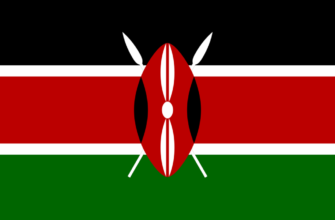Benin is located in western Africa along the coast of the Gulf of Guinea. It has a total area of 112.6 thousand km2.
Independence means a lot to the people of Benin and to the whole of Africa. Therefore, it is no coincidence that the color scheme tightly echoes the symbol of black freedom, the Pan-African flag.
France ruled Dahomey (Benin) until 1960. French is also used as the official language in the modern Presidential Republic of Benin.
This is what the modern flag of Benin looks like:

History of the flag
The flag and the development of the state are closely linked.
November 16, 1959 is the official birth of the national flag of Benin, then the country was called – Dahomey.
In 1975, Dahomey and its flag left, and the Marxists came to the leadership of the country with their symbols of power (red flag with a green star) and the new name – the Republic of Benin.

Fifteen years later, on August 1, 1990, the return of the modern flag and the emergence of a new country, the Presidential Republic of Benin.
Military coups are a part of the past life of the state. But it is also reminded by the colors of the flag.
Description
Benin’s freedom is expressed by the flag of three identical parts. It is part of the group of flags of African bicolor states with a vertical stripe.
One vertical one along the staff on the left is green. The other two horizontal stripes are yellow (top) and red (bottom).
Flag colors
The three-color national flag:
- Green.
- Yellow.
- Red.
Meaning of colors and flag symbol
Benin adopted the traditional Pan-African colors of the continent: green, red, yellow. Only black, symbolizing the Negro race and the memory of the enslavement of Africa, was not used.
- Green. Symbol of the fertility of the land and the rebirth of life.
- Yellow. Expresses the wealth of a country, the sun, the well-being of each of its people.
It is also a symbol of labor and prosperity.
The country’s population is heterogeneous in its ethnic composition. More than 60 peoples represent various folk crafts: potters, bone carvers, weavers, masters of bronze. Vivid folklore. Excellent fishermen.
- Red. It speaks of the strength and courage of the ancestors, shown in the struggle for independence.
The color of the blood of the defenders of the rights of people with dark skin. The centuries-long struggle against colonizers and enslavement. The determination and courage of the fighters.
Porto Novo is the capital of Benin and the guardian of its political power and its symbols.
The flag of Benin reminds everyone of past events and of the country’s confidence in a beautiful future.
General information about Benin
| Official language | French |
| Capital | Porto Novo, Cotonou |
| Territory | 112 622 km2 |
| Population | 10 741 458 |
| Currency | CFA franc |
| Phone Code | +229 |









